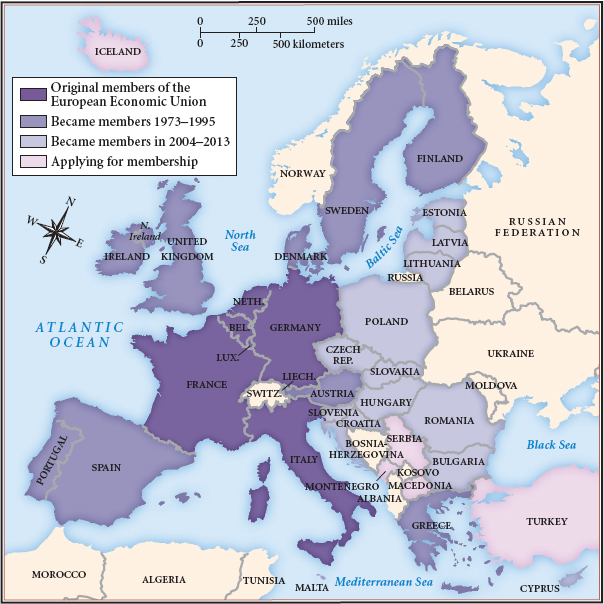America’s History: Printed Page 1005
America: A Concise History: Printed Page 913
America’s History: Value Edition: Printed Page 893
The Rise of the European Union and China
During the Cold War, the United States and the Soviet Union dominated the global balance of power. These two superpowers oversaw what observers called a bipolar world — two powerful poles, one capitalist and the other communist, around which global geopolitics were organized. Since the early 1990s, however, a multipolar world has emerged — with centers of power in Europe, Japan, China, and the United States, along with rising regional powers such as India and Brazil (America Compared).

In 1992, the nations of Western Europe created the European Union (EU) and moved toward the creation of a single federal state, somewhat like the United States. By the end of the 1990s, the European Union embraced more than twenty countries and 450 million people — the third-largest population in the world, behind China and India — and accounted for a fifth of all global imports and exports. In 2002, the EU introduced a single currency, the euro, which soon rivaled the dollar and the Japanese yen as a major international currency (Map 31.1). Militarily, however, the EU remained a secondary power. An economic juggernaut and trading rival with a suspicion of warfare, the EU presented a number of new dilemmas for American officials.
So did China, a vast nation of 1.3 billion people that was the world’s fastest-rising economic power in the first decade of the twenty-first century. Between 2000 and 2008, China quadrupled its gross domestic product (GDP). Economic growth rates during those years were consistently near 10 percent — higher than the United States achieved during its periods of furious economic growth in the 1950s and 1960s. Although still governed by the Communist Party, China embraced capitalism, and its factories produced inexpensive products for export, which Americans eagerly purchased — everything from children’s toys and television sets to clothing, household appliances, and video games. To maintain this symbiotic relationship, China deliberately kept its currency weak against the American dollar, ensuring that its exports remained cheap in the United States.
Beneficial to American consumers in the short run, the implications of this relationship for the future may be less promising. Two such implications stand out. First, as more and more goods that Americans buy are produced in China, the manufacturing base in the United States continues to shrink, costing jobs and adversely affecting communities. Second, China has kept its currency low against the dollar primarily by purchasing American debt. China now owns nearly 25 percent of total U.S. debt, more than any other nation. Many economists believe that it is unwise to allow a single country to wield so much influence over the U.S. currency supply. Should this relationship continue unchanged, Americans may find their manufacturing sector contracting even more severely in the coming decades.
EXPLAIN CONSEQUENCES
Question
What were the major consequences for the United States of the economic rise of China and the European Union?